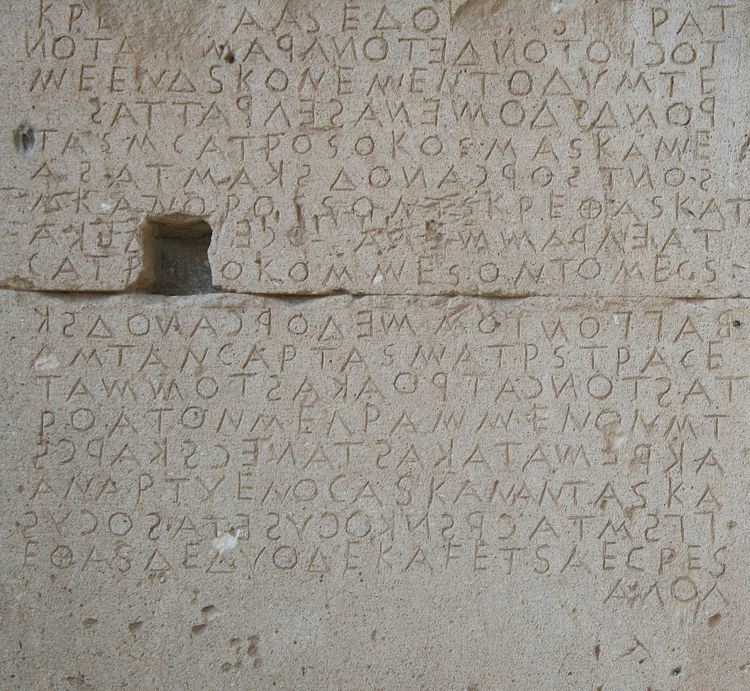 | ||
Boustrophedon /ˌbuːstrəˈfiːdən/ (Ancient Greek: βουστροφηδόν, boustrophēdón “ox-turning” from βοῦς, bous, “ox”, στροφή, strophē, “turn” and the adverbial suffix -δόν, "like, in the manner of"; that is, turning like oxen in ploughing) is a kind of bi-directional text, mostly seen in ancient manuscripts and other inscriptions. Every other line of writing is flipped or reversed, with reversed letters. Rather than going left-to-right as in modern European languages, or right-to-left as in Arabic and Hebrew, alternate lines in boustrophedon must be read in opposite directions. Also, the individual characters are reversed, or mirrored. It was a common way of writing in stone in Ancient Greece.
Contents
Explanation
Many ancient scripts, such as Safaitic and Sabaean, were frequently or typically written boustrophedonically, but in Greek it is found most commonly in archaic inscriptions, becoming less and less popular throughout the Hellenistic period.
By analogy, the term may be used in other areas to describe this kind of alternation of motion or writing. For example, it is occasionally used to describe the print head motion of certain dot matrix printers. In that case, while the print head moves in opposite directions on alternate lines, the printed text is usually not in boustrophedon format.
The Hungarian folklorist Gyula Sebestyén (1864-1946) writes that ancient boustrophedon writing resembles how the Hungarian rovás-sticks of old Hungarian writing were made by shepherds. The notcher holds the wooden stick in his left hand, cutting the letters with his right hand from right to left. When the first side is complete, he flips the stick over vertically and starts to notch the opposite side in the same manner. When unfolded horizontally (as in the case of the stone-cut boustrophedon inscriptions), the final result is writing which starts from right to left, and continues from left to right in the next row, with letters turned upside down. Sebestyén states that the ancient boustrophedon writings were copied from such wooden sticks with cut letters, applied for epigraphic inscriptions (not recognizing the real meaning of the original wooden type).
Reverse boustrophedon
The wooden boards and other incised artifacts of Rapa Nui also bear a boustrophedonic script called Rongorongo, which remains undeciphered. In Rongorongo the text in alternate lines was rotated 180 degrees rather than mirrored; this is termed reverse boustrophedon.
Example of Hieroglyphic Luwian
The Luwian language had a hieroglyph version, hieroglyphic Luwian, that read boustrophedon (most of the language was written down in cuneiform).
The Hieroglyphic Luwian is read boustrophedon, with the direction of any individual line pointing into the front of the animals or body parts constituting certain hieroglyphs. However, unlike Egyptian hieroglyphs with their numerous ideograms and logograms which show an easy directionality, the lineal direction of the text in hieroglyphic Luwian is harder to see.
Other examples
A modern example of boustrophedonics is the numbering scheme of sections within survey townships in the United States and Canada. In both countries, survey townships are divided into a 6-by-6 grid of 36 sections. In the U.S. Public Land Survey System, Section 1 of a township is in the northeast corner, and the numbering proceeds boustrophedonically until Section 36 is reached in the southeast corner. Canada's Dominion Land Survey also uses boustrophedonic numbering, but starts at the southeast corner.
Rongorongo is the current theory of the first written language on Easter Island. It is believed to be written in boustrophedonics, yet no accurate translation has been deciphered. Rongorongo shares many characterestics with other Polynesian languages groups.
The term is used by postmen in the United Kingdom to describe street numbering which proceeds serially in one direction then turns back in the other. (The same numbering method is used in some European cities.) This is in contrast to the more common method of odd and even numbers on opposite sides of the street.
In art history, it additionally means that you read from bottom left in a series of pictures; as in the stained glass windows at Sainte-Chapelle in Paris.
Another example is the boustrophedon transform, known in mathematics.
Sometimes computer printers with a typewriter-like moving type head print boustrophedon text if set up incorrectly.
The IBM 1360 Photo-Digital Storage System records its data boustrophedonically.
Additionally, the Indus script, although still undeciphered, can be written boustrophedonically.
The Avoiuli script used on Pentecost Island in Vanuatu can be written boustrophedonically.
In constructed languages
The constructed language Ithkuil uses a boustrophedon script.
The Atlantean language created by Marc Okrand for Disney’s 2001 film Atlantis: The Lost Empire is written in boustrophedon to recreate the feeling of flowing water.
The code language used in The Montmaray Journals, Kernetin, is written boustrophedonically. It is a combination of Cornish and Latin and is used for secret communication.
